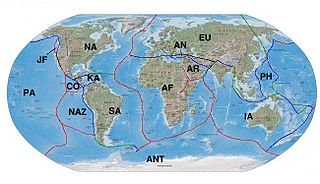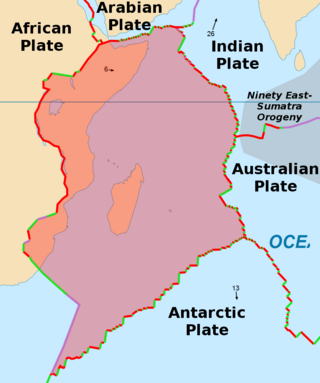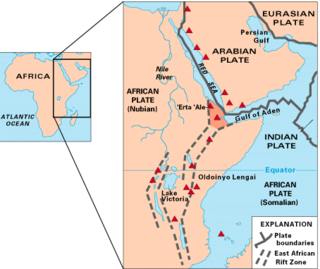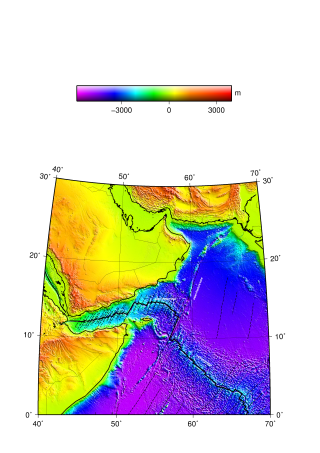
In plate tectonics, a divergent boundary or divergent plate boundary is a linear feature that exists between two tectonic plates that are moving away from each other. Divergent boundaries within continents initially produce rifts, which eventually become rift valleys. Most active divergent plate boundaries occur between oceanic plates and exist as mid-oceanic ridges.

The Indo-Australian Plate is a major tectonic plate that includes the continent of Australia and the surrounding ocean and extends north-west to include the Indian subcontinent and the adjacent waters. It was formed by the fusion of the Indian and the Australian plates approximately 43 million years ago. The fusion happened when the mid-ocean ridge in the Indian Ocean, which separated the two plates, ceased spreading. Contemporary models suggest at present there is a deformation zone between the Indian and Australian plates with both earthquake and global satellite navigation system data indicating that India and Australia are not moving on the same vectors northward. These observations are consistent with earlier evidence that the Indian Plate and Australian Plate have been acting as separate plates for at least the last 3 million years. In due course, some expect a localized boundary to reform between the Indian and Australian plates.

The Australian Plate is a major tectonic plate in the eastern and, largely, southern hemispheres. Originally a part of the ancient continent of Gondwana, Australia remained connected to India and Antarctica until approximately 100 million years ago when India broke away and began moving north. Australia and Antarctica had begun rifting by 96 million years ago and completely separated a while after this, some believing as recently as 45 million years ago, but most accepting presently that this had occurred by 60 million years ago.

The Somali Plate is a minor tectonic plate which straddles the Equator in the Eastern Hemisphere. It is currently in the process of separating from the African Plate along the East African Rift Valley. It is approximately centered on the island of Madagascar and includes about half of the east coast of Africa, from the Gulf of Aden in the north through the East African Rift Valley. The southern boundary with the Nubian-African Plate is a diffuse plate boundary consisting of the Lwandle Plate.

A mid-ocean ridge (MOR) is a seafloor mountain system formed by plate tectonics. It typically has a depth of about 2,600 meters (8,500 ft) and rises about 2,000 meters (6,600 ft) above the deepest portion of an ocean basin. This feature is where seafloor spreading takes place along a divergent plate boundary. The rate of seafloor spreading determines the morphology of the crest of the mid-ocean ridge and its width in an ocean basin.

The East African Rift (EAR) or East African Rift System (EARS) is an active continental rift zone in East Africa. The EAR began developing around the onset of the Miocene, 22–25 million years ago. It was formerly considered to be part of a larger Great Rift Valley that extended north to Asia Minor.

The Carlsberg Ridge is the northern section of the Central Indian Ridge, a divergent tectonic plate boundary between the African Plate and the Indo-Australian Plate, traversing the western regions of the Indian Ocean.

The Afar Triple Junction is located along a divergent plate boundary dividing the Nubian, Somali, and Arabian plates. This area is considered a present-day example of continental rifting leading to seafloor spreading and producing an oceanic basin. Here, the Red Sea Rift meets the Aden Ridge and the East African Rift. The latter extends a total of 6,500 kilometers (4,000 mi) from the Afar Triangle to Mozambique.

The Aden Ridge is a part of an active oblique rift system located in the Gulf of Aden, between Somalia and the Arabian Peninsula to the north. The rift system marks the divergent boundary between the Somali and Arabian tectonic plates, extending from the Owen Transform Fault in the Arabian Sea to the Afar Triple Junction or Afar Plume beneath the Gulf of Tadjoura in Djibouti.
The Aden-Owen-Carlsberg Triple Junction (AOC), also known as the Arabia–India–Somalia Triple Junction, is a triple junction that connects the Aden Ridge, Owen Fracture Zone, and Carlsberg Ridge in the northwest Indian Ocean. It has been described as one of only three RRF (ridge-ridge-fault) triple junctions on Earth, besides the Azores Triple Junction and Chile Triple Junction. However, because the fault arm of such unstable triple junctions tend to evolve into a spreading centre, all three cases have quickly evolved into stable RRR triple junctions.

The Central Indian Ridge (CIR) is a north–south-trending mid-ocean ridge in the western Indian Ocean.

The Rodrigues Triple Junction (RTJ), also known as the Central Indian [Ocean] Triple Junction (CITJ) is a geologic triple junction in the southern Indian Ocean where three tectonic plates meet: the African Plate, the Indo-Australian Plate, and the Antarctic Plate. The triple junction is named for the island of Rodrigues which lies 1,000 km (620 mi) north-west of it.

The Southwest Indian Ridge (SWIR) is a mid-ocean ridge located along the floors of the south-west Indian Ocean and south-east Atlantic Ocean. A divergent tectonic plate boundary separating the Somali Plate to the north from the Antarctic Plate to the south, the SWIR is characterised by ultra-slow spreading rates (only exceeding those of the Gakkel Ridge in the Arctic) combined with a fast lengthening of its axis between the two flanking triple junctions, Rodrigues (20°30′S70°00′E) in the Indian Ocean and Bouvet (54°17′S1°5′W) in the Atlantic Ocean.

The Macquarie Triple Junction is a geologically active tectonic boundary located at 61°30′S161°0′E at which the historic Indo-Australian Plate, Pacific Plate, and Antarctic Plate collide and interact. The term Triple Junction is given to particular tectonic boundaries at which three separate tectonic plates meet at a specific, singular location. The Macquarie Triple Junction is located on the seafloor of the southern region of the Pacific Ocean, just south of New Zealand. This tectonic boundary was named in respect to the nearby Macquarie Island, which is located southeast of New Zealand.

Gondwana was a large landmass, sometimes referred to as a supercontinent. The remnants of Gondwana make up around two-thirds of today's continental area, including South America, Africa, Antarctica, Australia, Zealandia, Arabia, and the Indian Subcontinent.
The geology of Socotra is part of the national geology of Yemen. Ancient Precambrian metamorphic rocks are intruded by younger igneous rocks, overlain by limestones and other marine sediments that deposited during marine transgression periods in the Cretaceous and the past 66 million years of the Cenozoic. The island is on the Somali Plate, which rifted away from the Arabian mainland within the past 60 million years.
The 1998 Azores Islands earthquake struck with an epicenter in the Atlantic Ocean, off the Azores Islands of Portugal at 05:19 local time. The shallow mainshock, which measured 6.1 on the moment magnitude scale caused significant damage on the island of Faial and Corvo. At least 10 people died, 100 were injured, and 2,500 people were left without homes.
The 1816 North Atlantic earthquake occurred on 2 February somewhere between the Azores Islands and Lisbon, Portugal. The estimated moment magnitude 8.3–8.9 earthquake had an epicenter offshore in the Atlantic Ocean, and was felt in Lisbon at 00:40 local time. Little is known about the quake, but it is believed to be one of the largest to have struck the Atlantic.












